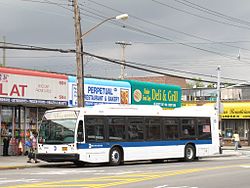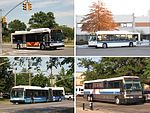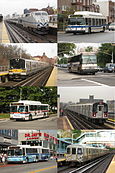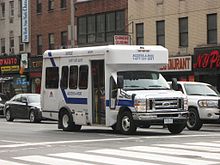- New York City Transit buses
-
New York City Transit buses 

MTA New York City Bus #8034 makes a stop on the B6 Limited in Canarsie, Brooklyn.Slogan Improving...non-stop. Parent MTA Regional Bus Operations Founded 1953 Headquarters 2 Broadway, New York, NY 10004-2207 Locale New York City Service area Manhattan, The Bronx, Brooklyn, Staten Island, parts of Queens Service type Local, limited-stop, express, and BRT bus service Routes - 181 local and limited-stop routes
- 27 express bus routes
- 2 Select Bus Service routes
Stops 12,499 Fleet 4372 fixed-route
Approxmiately 1500 ADA paratransit[1]Daily ridership 2.4 million daily (2006)[2] Fuel type - Compressed natural gas
(Jackie Gleason and West Farms depots only) - #2 diesel
(all except Jackie Gleason depot)
Operator Web site NYC Transit New York City Transit buses, marked on the buses MTA New York City Bus, is a bus service that operates in all five boroughs of New York City, employing over 4300 buses[3] on 219 routes[4] within the five boroughs of New York City in the United States. The bus system is meant to complement the MTA's rail lines - the New York City Subway, Staten Island Railway, Long Island Rail Road, and Metro-North Railroad.
Contents
Operations
See also: List of bus routes in the Bronx, List of bus routes in Brooklyn, List of bus routes in Manhattan, List of bus routes in Queens, List of bus routes in Staten Island, List of local and express multi-borough bus routes in New York City, and New York City transit faresNew York City Transit bus routes are spread out citywide. Some lines, such as the Q5 and Q85 cross the Nassau County border to go the Green Acres Mall in Valley Stream. The Q2 and Q110 leave Queens as they run along Hempstead Turnpike and onto the Cross Island Parkway, and Belmont Racetrack in Elmont, where they re-enter the city. The Q46 runs along Lakeville Road in Lake Success, Nassau County upon entering Long Island Jewish Medical Center. The Bx16 bus runs in to Westchester County for two blocks in Mount Vernon. The Bx7 and the Bx10 both make their last stops at the Bronx-Westchester border. The S89 is the only route to have a stop outside state borders, terminating at the 34th Street Hudson-Bergen Light Rail station in Bayonne, New Jersey. Some Staten Island express routes run via New Jersey, but do not stop in the state.
Buses are labeled with a number and a prefix identifying the primary borough (B for Brooklyn, Bx for the Bronx, M for Manhattan, Q for Queens, and S for Staten Island). Express buses use the letter X rather than a borough label. Lettered suffixes can be used to designate branches or variants.
MTA Bus Company routes also follow this scheme, and MTA Long Island Bus uses N for Nassau County. W or BL and S are commonly used by the non-MTA Bee-Line Bus System (Westchester County) and Suffolk Transit (Suffolk County).
Between 10:00 PM (22:00) and 5:00 AM (05:00) "Request-a-Stop" service is available. The bus operator may discharge passengers at a location along the route that is not a bus stop, as long as it is considered safe. If the location is not "safe", the bus operator will discharge passengers at the nearest safe location. The same policy also applies to MTA Bus and Long Island Bus service (with restrictions for Long Island Bus).[5]
Local and limited-stop service
Local and limited-stop buses provide service within a borough, or in some cases across two. While local buses make all stops along a route, limited-stop buses only make stops at busy transfer points, points of interest, and heavily used roadways. Limited stop service was first attempted with the M4 bus during rush hours in 1973, then expanded to other routes from there. The usual setup is that limited stop service runs the full route, while local services run only in the limited stop area, and the limited stop buses run local at the tail ends of the route not served by locals, similar to the operation of some subway lines and the Staten Island Railway.
The following New York City Bus routes run limited stop service:
- Bronx: Bx1, Bx36[6] Bx41 and Bx55
- Brooklyn: B6, B35, B38, B41, B44, B46, B49 and B82
- Manhattan: M1, M2, M4, M5, M98 and M101
- Queens: Q4, Q5, Q17, Q27, Q36, Q43, Q44, Q46, Q58, Q83 and Q85
- Staten Island: S81, S84, S86, S89, S90, S91, S92, S93, S94, S96 and S98
Limited-Stop buses flash LIMITED on the destination sign and usually have an orange Limited sign in the windshield.
Select Bus Service
Main article: Select Bus ServiceSelect Bus Service (SBS), the brand name for MTA bus rapid transit service, is a variant of Limited-Stop bus service that requires fare payment to be made before boarding the bus, at fare payment machines in shelters at designated "stations" (such a shelter is shown to the left). Receipts given for payment of fare are "proof-of-payment" that must be shown to fare enforcement upon request. In the event of the fare machine failing to issue a receipt, the bus operator must be notified of the problem. The implementation of this new service is paired with new lane markings and traffic signs that reserve a lane for buses only between 7AM and 7PM.[7]
SBS began on the Bx12 Fordham Road/Pelham Parkway line in the Bronx on June 28, 2008. The M15 First/Second Avenues line saw SBS implementation on October 10, 2010, and the B44 Nostrand Avenue lines will see implementation in 2011. Variants are also being implemented on 34th Street, 5 Avenue, and Madison Avenue in Manhattan.[7][8]
Buses used in this service are identifiable with blue lights on the sides of the destination sign and "stations" be similar to those pictured to the right, and also have a "+selectbusservice" wrap identifying them as such buses. Locations of stops (and in some cases, the local bus stops) were shifted or eliminated where possible to prevent mixing of local bus customers. SBS is offered in conjunction with the New York City and New York State Department of Transportation.[9][10]
Express service
Express buses usually operate between Midtown Manhattan or Lower Manhattan and the other boroughs. While most express routes operate only during peak weekday hours, some routes (including the X1, X10, and X17 and various MTA Bus lines) run on a daily basis (the X27 and X28 run all day on weekdays), from about 5:00 AM to 1:00 AM. MCI and Prevost over-the-road coaches are used for express service.
Demand response
In addition to a 100% accessible bus fleet, New York City Transit also provides paratransit services under the Americans with Disabilities Act (ADA) of 1990 under the Access-A-Ride brand, for customers who cannot use regular bus or subway service servicing all five boroughs of New York City at all times.[11] This system was acquired from the NYC Department of Transportation in 1993.
Bus stops
Within New York City, the color of the route on a bus stop sign indicates the type of service run. Routes are branded on bus stop signs, which are normally located every 2-3 blocks apart in most cases, as follows:
Sign color Type of service Blue - Local bus service.
Purple - Limited-stop service.
Green - Express bus service.
Black - Service operating to a particular stop during late night hours only.
Turquoise - Select Bus Service (fare payment must be made at fare collection machines in the bus stop prior to boarding)
Yellow - Special school service (stopping at that stop only when New York City public schools are in session,
usually at the end of the school day).
Non-franchise services (such as private charter, suburban and tour services) have green lettering on white signage. Unless otherwise signed, bus stops are reserved for use of specified services at all times.
History
City involvement with surface transit in the city began in September 1919, when Mayor John Francis Hylan, through the New York City Department of Plant and Structures, organized private entrepreneurs to operate "emergency" buses to replace four abandoned storage battery streetcar lines: the Madison Street Line, Spring and Delancey Streets Line, Avenue C Line, and Sixth Avenue Ferry Line.[12] Many routes were soon added, replacing lines such as the Brooklyn and North River Line (trolleys)[13] and Queens Bus Lines (buses),[14] and the DP&S also began operating trolleys in Staten Island to replace the Staten Island Midland Railway's system.[15][16] Eventually all of these routes were transferred to private management.[citation needed]
Another city acquisition was the Bridge Operating Company, which ran the Williamsburg Bridge Local trolley, acquired in 1921 by the DP&S.[17] Unlike the other lines,[citation needed] this one remained city-operated, and was replaced by the B39 bus route on December 5, 1948, by then transferred to the New York City Board of Transportation.[18]
On February 23, 1947, the Board of Transportation took over the Staten Island bus network of the Isle Transportation Company. Further acquisitions were made on March 30, 1947 with the North Shore Bus Company in Queens, and September 24, 1948 with the East Side Omnibus Corporation and Comprehensive Omnibus Corporation in Manhattan. With the city takeover of the Brooklyn-Manhattan Transit Corporation's surface subsidiary, the Brooklyn and Queens Transit Corporation, on June 2, 1940,[19] the city gained a large network of trolley and bus lines, covering all of Brooklyn and portions of Queens.[20] The final Brooklyn trolleys were the Church Avenue Line and McDonald Avenue Line, discontinued on October 31, 1956,[21] though the privately-operated (by the Queensboro Bridge Railway) Queensboro Bridge Local remained until 1957.[22][23][24]
Thus, in the late 1950s, the city operated all local service in Staten Island and Brooklyn, about half the local service in Queens, and several routes in Manhattan. Several private companies operated buses in Queens, and the Avenue B and East Broadway Transit Company operated a small Manhattan system, but by far the largest system was the Fifth Avenue Coach Company and Surface Transit, which operated almost all Manhattan routes and all Bronx routes, plus two into Queens (15 Fifth Avene - Jackson Heights and TB Triborough Bridge and one within Queens (16 Elmhurst Crosstown). After a strike in 1962, the city took over operations. To avoid legal issues, a new agency, the Manhattan and Bronx Surface Transit Operating Authority (MaBSTOA)was formed to operate the former Fifth Avenue Coach Lines and Surface Transit, Inc.routes. The final acquisition was in 1980, when MaBSTOA took over the Avenue B and East Broadway's routes, using MaBSTOA equipment with Avenue B red route roll signs (NYCTA acquired the 13 Grumman Flxibles that had been assigned to Avenue B and placed them in NYCTA service).[citation needed] Public takeover of the remaining Queens buses, as well as most express routes, was implemented in 2005 and 2006 by the new MTA Bus Company.[25] In 2008, the operations of MTA Bus Company, NYC Transit, and Long Island Bus were all merged into a new regional operation, MTA Regional Bus Operations. The New York City Bus brand continues to be used.
 A typical vehicle, an MCI cruiser, used in express bus service.
A typical vehicle, an MCI cruiser, used in express bus service.
Fare
The base fare for riding any local or limited stop bus route is US$2.25 one-way trip (US$1.10 for seniors and disabilities), regardless of the distance traveled (transfers are available on request). An express bus fare costs US$5.50 each way (US$2.75 off-peak hours for seniors and disabilities). Fares are payable with a MetroCard or in exact change with coins (except Pennies and Half-Dollars). Only Express Bus Plus and Pay-Per-Ride (with at least a US$5.50 balance) MetroCards work on express buses. At one time, change was given by the driver on local buses. This practice ceased when the fare rose above 20¢.[26] Up to 3 children 44" tall and under can ride free with a fare-paying adult on a local bus. One child under 2 riding in the lap of a fare-paying customer may ride free on an express bus.
For Select Bus Services, fare must be paid at the bus stop prior to boarding the bus. All other procedures remain the same, except that customers needing a transfer must board via the front door.
Student MetroCards, issued by the New York City Department of Education Office of Pupil Transportation, are distributed to all eligible students in grades 1-12 throughout the city. These Metrocards have a different color scheme applied to it, grades 7-12 having green lettering on a white background and grade 1-6 having orange lettering on the white background. Depending on the distance between the student's home and school, a student might have to pay a half-fare ($1.10) in addition to dipping his card. The half-fare applies only to grades 7-12. These passes are normally valid Monday to Friday, 5:30 AM to 8:30 PM, for 3 rides a day (plus transfers) during the school year (some passes may have 4 trips plus transfers on them, or have Sunday eligibility). These passes are valid only for travel within New York City (but not valid on Bee-Line buses along Boston Road in the Bronx), and cannot be used for travel to and from Green Acres Mall.
Dollar bills are not accepted on any MTA buses (or Bee Line or Atlantic Express fixed-route buses, which use the same fare collection system), as a vacuum is used to collect coins from the fareboxes,[27] and the process would tear dollar bills.
When paying with change, a passenger can request a MetroCard Bus Transfer. It is valid for two hours and can be used only on Local and Limited Stop buses. In the 1970s, new bus transfers called "Add-A-Ride" coupons were made available, for half-fare, to supplement the then-current free bus transfers. Generally, the free transfers were only valid for travel via the same bus company/franchise.
Single fares were reduced to US$1.00 from US$2.00 for non-weekday dates during the 2005 holiday season and for the week from Christmas through New Year's holiday week. As of early 2006, the MTA was considering continuing this into future holiday seasons. The plan was ultimately dropped.
Garages and fleet
Main article: MTA Regional Bus Operations bus fleetMain article: Bus depots of the New York City Transit AuthorityMTA New York City Bus operates buses using conventional diesel, diesel-electric hybrid and compressed natural gas technology. The agency currently operates approximately 500 CNG coaches and over 900 diesel-electric buses, to grow to 1,286 by 2010.
Buses are dispatched from 20 garages across New York City, with heavy-duty maintenance done at three facilities throughout the city.
See also
- Manhattan and Bronx Surface Transit Operating Authority
- Metropolitan Transportation Authority (New York) bus fleet
References
- ^ NYCT data from the NTD database
- ^ MTA New York City Transit
- ^ About New York City Transit: Buses
- ^ MTA NYC Transit - Bus Route Information
- ^ MTA NYC Transit - How to Ride the Bus
- ^ http://mta.info/nyct/bus/schedule/bronx/bx036cur.pdf Bx36 Local and LTD
- ^ a b Riders Will Pay Before Boarding, and Save Time, on Revamped Bus Route, New York Times, June 29, 2008
- ^ "MTA Planning - NYC Bus Rapid Transit project". http://www.mta.info/mta/planning/sbs/faqs.htm. Retrieved 2008-06-24.
- ^ "MAYOR BLOOMBERG, MTA EXECUTIVE DIRECTOR AND CEO SANDER, AND DOT COMMISSIONER SADIK-KHAN UNVEIL NEW MTA SELECT BUS SERVICE (SBS) SYSTEM". 2008-03-25. http://www.nyc.gov/portal/site/nycgov/menuitem.c0935b9a57bb4ef3daf2f1c701c789a0/index.jsp?pageID=mayor_press_release&catID=1194&doc_name=http%3A%2F%2Fwww.nyc.gov%2Fhtml%2Fom%2Fhtml%2F2008a%2Fpr101-08.html&cc=unused1978&rc=1194&ndi=1. Retrieved 2008-06-22.
- ^ "NYC's First - And Only? - Bus Rapid Transit route". 2008-03-25. http://blog.tstc.org/2008/03/25/nycs-first-and-only-bus-rapid-transit-route/. Retrieved 2008-06-22.
- ^ MTA Paratransit services description
- ^ New York Times, East Side Bus Line Gets City Permit, September 19, 1919, page 6
- ^ New York Times, Brooklyn Bus Line Starts, October 6, 1919, page 36
- ^ New York Times, Queens Bus Routes Taken Over by City, September 19, 1926, page 24
- ^ New York Times, Says City Cleared $4,359 on Car Line, July 18, 1921, page 14
- ^ Zachary M. Schrag, The Bus Is Young and HonestPDF (2.86 MiB)
- ^ New York Times, City to Run Bridge Line, February 5, 1921, page 22
- ^ Bridge Cars of '04 Yielding to Buses, December 2, 1948, page 58
- ^ New York Times, B.M.T. Lines Pass to City Ownership, June 2, 1940, page 1
- ^ Railway Directory and Yearbook, 1967
- ^ New York Times, Trolley Era Ends Today On City-Operated Lines, October 31, 1956, page 35
- ^ New York Times, End Soon of Two Brooklyn Trolley Lines Will Leave City With but One Short Route, December 30, 1955, page 15
- ^ New York Times, Queensboro Bridge Trolley Line, Last One Here, Appears Doomed, March 20, 1957
- ^ New York Times, City's Last Trolley at End of Line, April 7, 1957, page 1
- ^ MTA — City Law Breakfast with Elliot G. Sander
- ^ Fare information
- ^ Picture of the vacuuming the coins out of the fare box
External links
- Official MTA New York City Transit Bus page
- Urban Transit Club (UTC) New York City Bus Roster
- Comparative Study of Diesel vs Hybrid Buses operating in NYC. National Renewable *[http://www.busandcoachdirectory.com/North-America/United-States-of-America/New-York.html New York Bus & Coach Directory] Energy Laboratory (NREL) Nov 2006
MTA Regional Bus Operations Services New York City Bus • Long Island Bus (ends December 31, 2011) • MTA Bus
Routes Bronx (Bx-) • Brooklyn (B-) • Manhattan (M-) • Queens (Q-) • Staten Island (S-) • Nassau (N-) (ends December 31, 2011) • Express (x-, BM-, BxM-, QM-)Fleet Major hubs 165th Street Bus Terminal • Eltingville Transit Center • Hempstead Transit Center • St. George Ferry TerminalOther Fares • MetroCard • Manhattan and Bronx Surface Transit Operating Authority • Hudson Rail Link • Select Bus Service • New York City Bus garages • MTA Bus garages • Long Island Bus garages • Transportation in New York City • Mass transit in New York CityOfficial websites : New York City Bus/MTA Bus • Long Island BusMetropolitan Transportation Authority of the State of New York Bus 
Rapid transit Commuter rail Crossings MTA Bridges and TunnelsLaw enforcement Fleet Other Categories:- MTA Regional Bus Operations
- Bus transportation in New York City
- Surface transportation in Greater New York
- 1953 introductions
Wikimedia Foundation. 2010.











